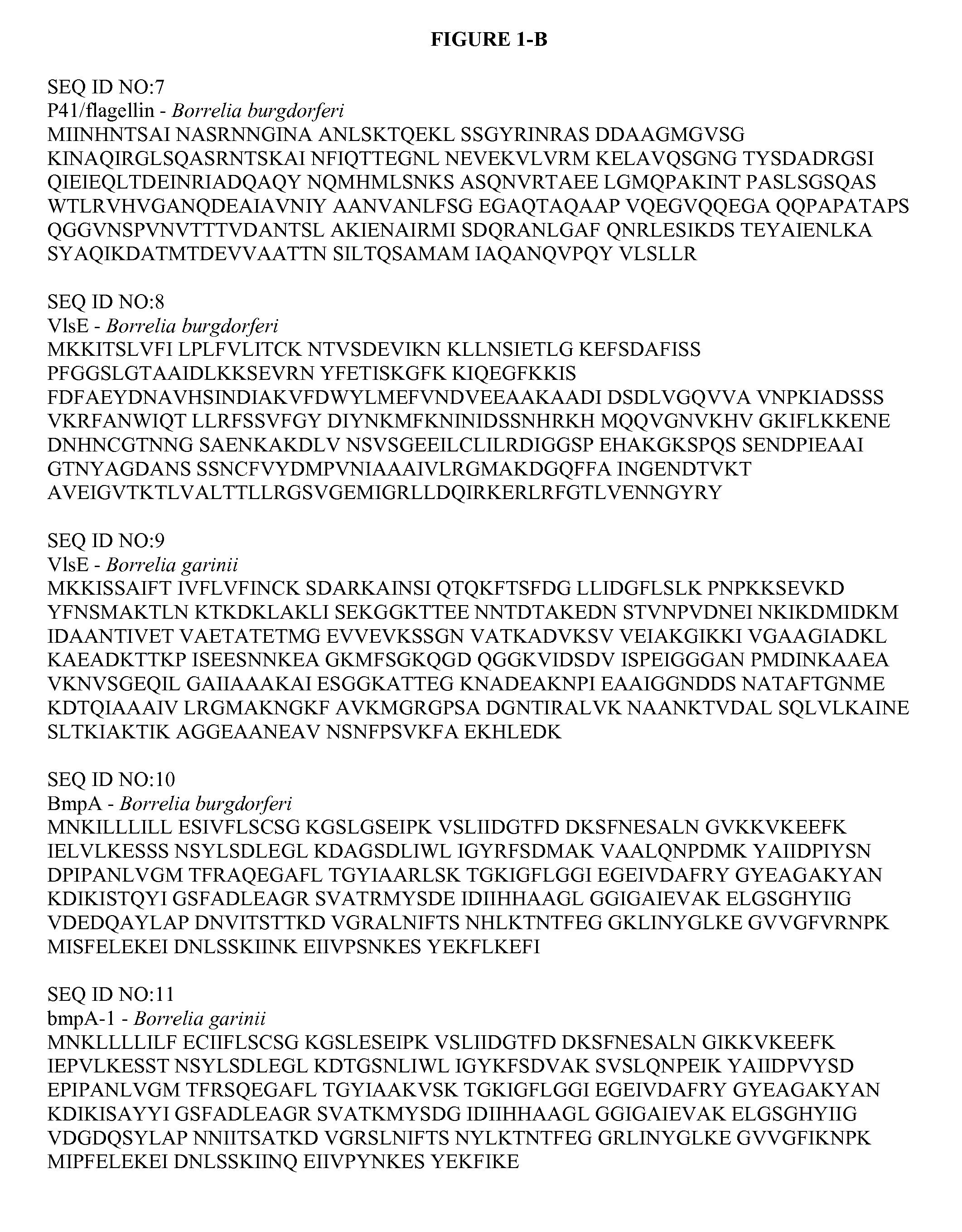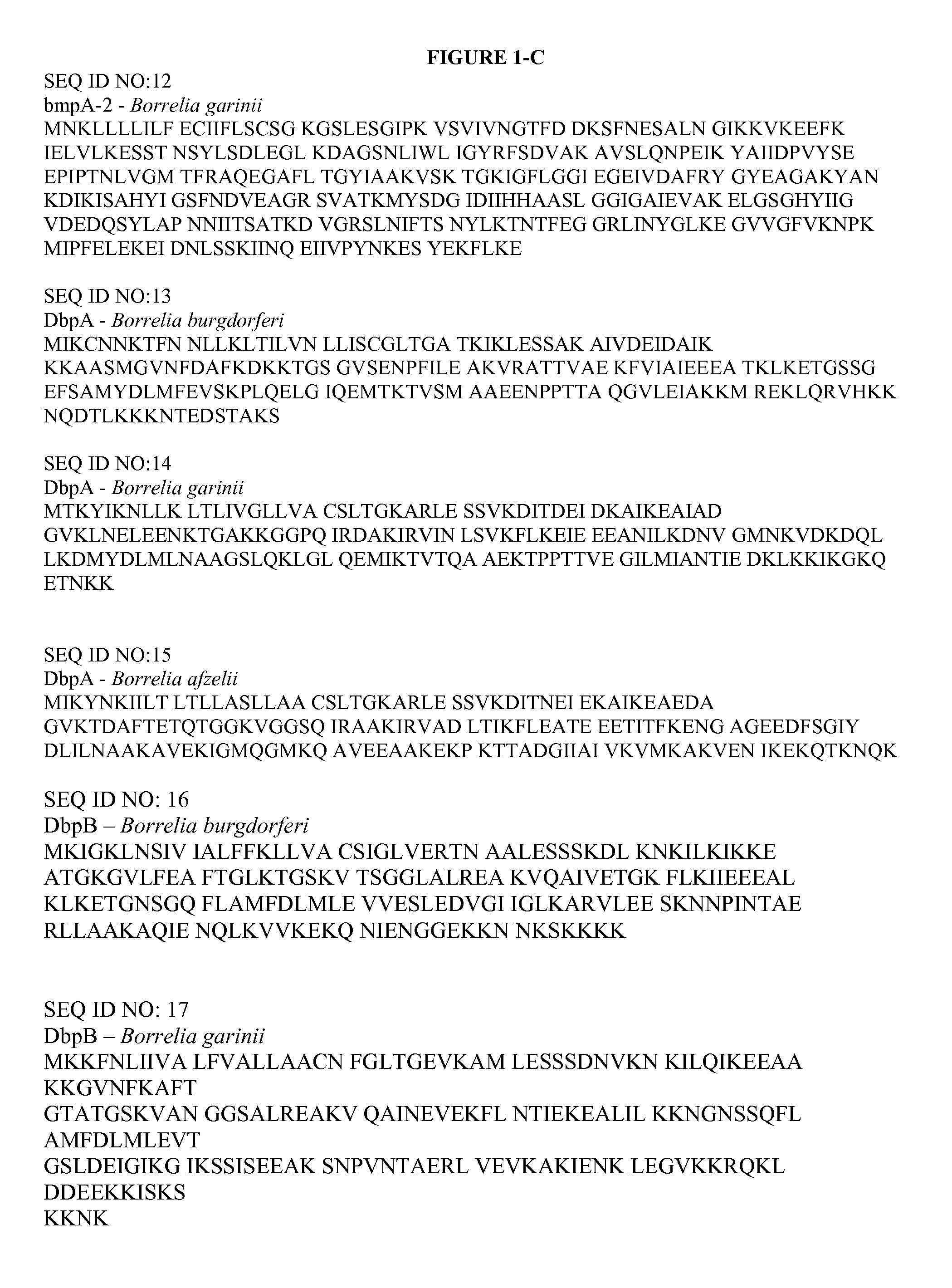Compositions and methods for diagnosing and monitoring disease and treatment via antigen-specific molecules
a technology of antigen-specific molecules and compositions, applied in the field of compositions and methods for diagnosing and monitoring treatment for sensitivity to an antigen, can solve the problems of many available laboratory assays yielding unreliable results, difficult early detection of lyme disease, and inability to accurately detect lyme disease, etc., to achieve substantial value for clinical use and optimize treatment
- Summary
- Abstract
- Description
- Claims
- Application Information
AI Technical Summary
Benefits of technology
Problems solved by technology
Method used
Image
Examples
example 1
Methods of Cell and Reagent Preparation
Cell Preparation
[0067]Sixteen milliliters (mL) of Lymphoprep™ solution (Axis-Shield, Oslo, Norway) is spun down in a greiner tube at 2800 rpm (1825 g) for 1-2 minutes at room temperature. Any fluid that is above the filter is removed. Any unused tubes are kept at 4° C. until use. Tubes can be warmed in a waterbath or incubator before use.
[0068]Blood should be collected in 3.2% citric acid and kept at room temperature. After tube warm-up, add up to 16 mL whole blood to each tube by pouring the blood from two vacutainers. The tubes are centrifuged at 2800 rpm (1825 g) for 15 minutes at room temperature. Some serum is removed and then the tube is swirled to mix the buffy layer and loosen cells from the tube walls. The buffy layer is poured into a fresh 50 mL tube. The tube is filled with Dulbecco's Phosphate Buffered Saline (PBS), or with HBSS without calcium and magnesium. Buffers should be at pH 7.0. The tubes are spun at 1600 rpm (596 g) for 10...
example 2
Immune Tolerance Test
[0072]Culture plates are precoated with recombinant Borrelia antigens in 50 μL / well medium without human serum. The coated plates are wrapped in parafilm and stored at −20 C until use.
[0073]To all wells add 50 μL of prepared solution. The IFN-alpha concentration should be 6250-7500 Units per well. PBMCs (1×10 in 1 mL of 10% medium) are pipetted into the 24-well cell culture plate pre-coated with Borrelia antigens in single dilutions, and incubated at 37 C with 5% CO. One negative control (lymphocytes in 10% medium without antigen) and one positive control (lymphocytes in 10% medium plus 2 μg / mL pokeweed mitogen) are included on each plate. On cell culture day 5, the culture is pulsed for 5 hours with 3 μCi 25 methyl-3H-thymidine (30 μL / well of a 1:10 dilution (with PBS) of stock Thymidine, 5 mCi / 5 mL) and the radioactivity is measured in a liquid scintillation counter. Cell proliferation is recorded as counts per minute (cpm) which are converted to a stimulation...
example 3
[0074]Venous blood is obtained from healthy individuals (the control group) or patients in yellow top tubes (ACD tubes). PBMCs are isolated from peripheral blood using commercially available Ficoll-Hypaque density gradients, washed twice with phosphate-buffered saline, and resuspended in complete culture medium at a concentration of 1×106 cells per mL. Cells are cultured alone, with Borrelia antigens, or with 5 μg / mL phytohemagglutinin (PHA) at 37 C and 5% CO2. The cell-free supernatants are collected after 24 hours by centrifugation, divided into aliquots and stored at −80 C until use.
[0075]Following the cell cultures, stimulated and non-stimulated PBMCs supernatants are then assayed using the 96-well Bio-Plex suspension array system, which utilizes xMAP detection technology (Bio-Rad Corporation, Hercules, Calif.). The cytokines measured are IL-10, IL-6, IL-8, IL-10, IL-13, MCP-1, G-CSF, IFN-γ, and TNF-α. The principle of these 96-well plate-formatted magnetic bead-ba...
PUM
| Property | Measurement | Unit |
|---|---|---|
| Fraction | aaaaa | aaaaa |
Abstract
Description
Claims
Application Information
 Login to View More
Login to View More - R&D
- Intellectual Property
- Life Sciences
- Materials
- Tech Scout
- Unparalleled Data Quality
- Higher Quality Content
- 60% Fewer Hallucinations
Browse by: Latest US Patents, China's latest patents, Technical Efficacy Thesaurus, Application Domain, Technology Topic, Popular Technical Reports.
© 2025 PatSnap. All rights reserved.Legal|Privacy policy|Modern Slavery Act Transparency Statement|Sitemap|About US| Contact US: help@patsnap.com



